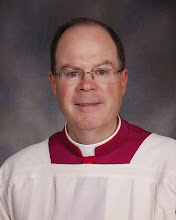Saturday, November 5, 2011
Visit of the Dominican Nuns (Sunday 32.A)
While the usually-cloistered Dominican Nuns await the completion of their monastery near Squamish, BC, they are able to visit parishes; this Sunday we welcomed them to our morning Masses.
We're all hoping that the changes in the translation of the Mass are going to help us worship God reverently and profoundly. Many blessings have come from the liturgical renewal of the past forty years, but we know there are blessings still to come.
And of course, there have been some not-quite-blessed moments during those forty years. Vancouver escaped the worst of them, such as liturgical dance. I once heard the story of a religious Sister who danced the offertory procession in a flowing costume while playing the guitar. The bishop was visiting the parish on the occasion.
As the Sister approached the altar, the bishop whispered to the pastor: "If she asks for your head on a platter, she'll get it!"
I'm sure it's not a true story, and anyway our visitors today aren't that kind of Sister. We have in church with us the Nuns from Queen of Peace Monastery. These Sisters belong to the contemplative branch of the Order of Preachers, better known as the Dominicans.
St. Dominic made the brilliant decision to establish a community of Nuns to pray for the men he would send out as preachers of the Gospel. He knew that contemplation should precede action.
It's a hard concept for busy people in the modern world. "What do these Nuns do?" some people ask. Don't they run anything?
Today's readings tell us about these Sisters' calling. The Book of Wisdom explains that Wisdom is waiting to be found by those who take the trouble to seek her. Some effort is involved—the reading points out that getting up early makes it easier to find Wisdom—but her riches are a free gift.
In her book The Sacred Place of Prayer, Sister Jean Marie Dwyer (who can't be with us this morning) shows that even the great philosopher Aristotle taught that the pursuit of wisdom reached its highest point in contemplation. Aristotle saw contemplation as the fullest realization of our potential and the final purpose of human action.
Although Aristotle did not know the truth of a personal God, he knew that contemplation, rather than action, was the high road to blessedness. *
In today's Gospel, we can see the vocation of consecrated contemplatives represented by the wise bridesmaids. A beautiful Vatican document on the contemplative life says that "the nun is called to converse with the divine Bridegroom, meditating upon his law day and night so as to receive as gift the Wisdom of the Word and to become one with him, under the impulse of the Holy Spirit."
That sounds wonderful, but what does it have to do with us—busy priests, tired parents (and grandparents), hard-working students, all caught up in the whirl of the world?
The quick and easy answer is that we can ask contemplatives to do some of our praying for us. They offer a service of prayer to the Church and for all who ask their help. When I have big problems, Queen of Peace Monastery is my first call.
But that's not really the answer I want to leave with you today. The biggest service the Nuns offer to us is this: they are a reminder that the Bridegroom is coming. Like the wise bridesmaids, they keep their lamps lit and offer us an example of wisdom. By their special relationship to the divine Bridegroom, they keep before us a central fact: "As the Redeemer of the world, Christ is the Bridegroom of the Church. The Eucharist is the Sacrament of our Redemption. It is the Sacrament of the Bridegroom and of the Bride."++
Sunday Mass offers us an experience of community and fellowship; it restores us spiritually and nourishes us intellectually; it provides peace and strength. But we must never forget the height and the depth and the beauty and the richness of the Eucharistic celebration. It is the Sacrament of the Bridegroom and the Bride.
We need to wake up if we have dozed off to the full meaning and power of the Mass. The visit of the Sisters, and the drawing-near of the new translation, should encourage us to pray fervently to God for the wisdom to seek him in the sanctuary, and for the grace to see his strength and glory.
* Jean Marie Dwyer, OP, The Sacred Place of Prayer: The Human Person Created in God's Image, Novalis 2011, pp. 30-31.
+ Congregation for Institutes of Consecrated Life and for Societies of Apostolic Life, Verbi Sponsa, Instruction on the Contemplative Life and on the Enclosure of Nuns (1999) n. 5.
++ John Paul II, Apostolic Letter Mulieris Dignitatem (1988), n. 26.
Subscribe to:
Post Comments (Atom)


No comments:
Post a Comment